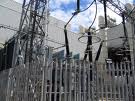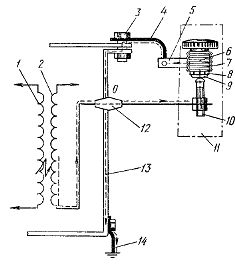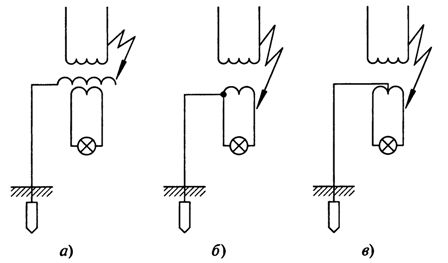Protection during the transition of a higher voltage to a lower network
 During operation, emergency direct connection is possible: windings of transformers with higher and lower voltage, conductors of overhead lines, circuits with different voltage through metal structures, etc. In all these cases, if protective measures are not taken, the potential of the wires in the low-voltage network will increase significantly, insulation failure will occur, and the unacceptable potential will spread to all metal parts of the installation connected to each other by grounding or ground network.
During operation, emergency direct connection is possible: windings of transformers with higher and lower voltage, conductors of overhead lines, circuits with different voltage through metal structures, etc. In all these cases, if protective measures are not taken, the potential of the wires in the low-voltage network will increase significantly, insulation failure will occur, and the unacceptable potential will spread to all metal parts of the installation connected to each other by grounding or ground network.
In the event of a short circuit between the windings on the upper and lower sides of the transformer, a higher voltage is applied to the low-voltage network, for which the insulation of the network and equipment is not designed. Most often, the voltage goes from the 6000 and 10000 V sides to the 380 V network.
If the high and low voltage networks operation with isolated neutral, then when the voltage passes, one of the phase conductors with respect to the ground is under a voltage equal to the sum of the phase voltages of the higher and lower sides (this can be any phase depending on the group of connection of the windings of the transformer, for example, phase A), and the other two under a voltage slightly below the phase voltage of the higher side. The consequence of such a transition is a short circuit to the equipment case and the appearance of high, touch and step voltage.
If the neutral of the low-voltage network is grounded, then the transition of the higher voltage is grounded, while the voltage of one of the phases to earth will be determined by the sum of the neutral voltage of the low-voltage network to earth and the phase voltage of the same network. and the other two phases will be less than the phase voltage of the same network. Re-grounding the neutral wire further reduces this voltage difference.
If the grounding of the neutral neutral is unacceptable in a low-voltage network, then the neutral is connected to the earthing device through a fault fuse. In the absence of neutral (connection of transformer windings in delta) or unavailability of neutral, one of the phases of the low-voltage network is grounded through a fault fuse.

Switching circuit and failure fuse operation: 1, 2 — high and low voltage coils, 3 — tank cap fastening bolt, 4 — jumper, 5 — fuse bracket, 6, 9 — contact top and bottom head, 7 — main contact, 8 — mica seal with candles, 10 — central contact, 11 — safety fuse, 12 — neutral input, 13 — tank wall, 14 — jumper for tank grounding.
The center contact 10 is connected to the neutral input 12 of the low voltage winding with a star circuit or with a line input with a delta circuit, the main contact is a clamp with a grounded tank (cover).
When a dangerous voltage occurs on the low voltage side, the air gaps of the mica seal are pierced by the resulting electric arc, the low voltage winding is connected to ground and thus acquires a potential equal to zero.
Breakout fuses are used at high voltage mains above 3000 V. When a higher voltage is passed, a failure fuse is energized from the higher side and breaks, the earth circuit is closed and the neutral or phase is earthed. This reduces the voltage. in the low-voltage network and triggers the protection in the high-voltage network. At a higher voltage of less than 3000 V, the breakdown fuse does not work, therefore in such networks the neutral of the lower side is grounded.
In networks with voltages up to 1000 V, to protect against danger when the higher voltage passes to the lower (usually low voltage) side, one of the terminals or the midpoint of the low voltage winding is earthed or neutralized, or an earthed shield or a screen winding is used between the higher and lower voltage windings of the transformer. … In the presence of a grounded screen or screen winding, the transition of the higher voltage to the lower network is impossible.

Protection against the transition of high voltage to the circuit of the lowest in the local and portable lighting network: a — the use of a screen winding, b — grounding of the end of the low voltage winding, c — grounding of the middle point of the low voltage winding
The consequences of voltage transition in local and portable lighting networks of 12 and 36 V, as well as in networks supplying hand tools, are deadly.
